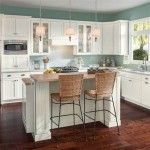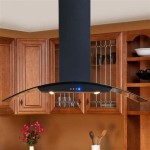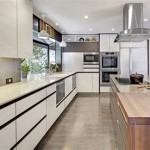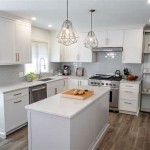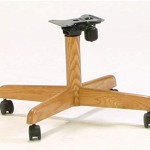Kitchen Cabinet Color Ideas For Small Kitchens
Small kitchens present unique design challenges. One of the most impactful decisions in a small kitchen renovation or refresh is the selection of cabinet colors. The right color palette can visually expand the space, enhance natural light, and create a more inviting and functional environment. Choosing wisely from a vast array of color options requires considering the overall design aesthetic, the amount of natural light available, and the existing elements in the kitchen, such as countertops, flooring, and appliances.
The perception of space is heavily influenced by color. Lighter colors tend to reflect more light, making a room feel more open and airy. Darker colors, conversely, absorb light, which can make a small space feel even smaller and more enclosed. Understanding these basic principles of color theory is crucial when planning a small kitchen color scheme.
Beyond the basic light-versus-dark concept, the overall tone of the color plays a significant role. Cool colors like blues, greens, and purples tend to recede, creating a sense of spaciousness. Warm colors like reds, oranges, and yellows advance, potentially making a room feel cozier, but also smaller. In a small kitchen, carefully balancing warm and cool tones is key to achieving a visually appealing and functional space.
Consideration should also be given to the style and architecture of the kitchen. A modern kitchen with sleek lines might benefit from a minimalist color palette, while a more traditional kitchen could incorporate richer, warmer hues. Furthermore, the amount of natural light available will significantly affect how colors appear. A kitchen with ample natural light can handle slightly darker colors without feeling cramped, while a kitchen with limited natural light will require lighter, more reflective colors to maximize brightness.
Optimizing Space with Light and Neutral Colors
Light and neutral colors are often the go-to choice for small kitchens due to their ability to reflect light and create an illusion of spaciousness. Shades of white, off-white, cream, and light gray are particularly effective in this regard. These colors provide a clean and airy backdrop, allowing other elements in the kitchen, such as countertops, backsplashes, and accessories, to stand out and add visual interest.
White cabinets are a classic and timeless option that works well in almost any kitchen style, from modern to traditional. White cabinets offer unparalleled versatility, pairing seamlessly with a wide range of countertop materials, flooring options, and appliance finishes. Furthermore, white reflects the maximum amount of light, making it an ideal choice for kitchens with minimal natural light.
Off-white and cream cabinets provide a similar effect to white, but with a slightly warmer and softer feel. These colors can be particularly appealing in kitchens where stark white might seem too clinical or sterile. Off-white and cream cabinets also tend to be more forgiving than pure white when it comes to hiding dirt and smudges, making them a practical choice for busy households.
Light gray cabinets offer a more contemporary alternative to white and off-white. Light gray provides a neutral backdrop while adding a touch of sophistication and elegance. It pairs well with both warm and cool tones, making it a versatile choice for a variety of kitchen styles. Light gray can also be used to create a subtle contrast with white walls or countertops, adding depth and visual interest to the space.
When using light and neutral colors in a small kitchen, it's important to add texture and visual interest through other design elements. Consider incorporating different textures in the backsplash, such as subway tile or textured glass. Adding pops of color through accessories, such as dishware, artwork, or plants, can also help to break up the monotony of a neutral color scheme.
Strategic Use of Accent Colors
While light and neutral colors are often the primary choice for small kitchens, incorporating accent colors can add personality, depth, and visual interest. The key is to use accent colors strategically and sparingly, avoiding overwhelming the space. Accent colors can be introduced through kitchen islands, lower cabinets, backsplashes, hardware, or accessories.
One popular approach is to paint the kitchen island a contrasting color. This can create a focal point and add visual interest to the space. For example, a navy blue or deep green island can provide a striking contrast against white or light gray perimeter cabinets. This strategy works particularly well in kitchens with a larger island that can handle a bolder color without overwhelming the space.
Another way to incorporate accent colors is through the lower cabinets. Painting the lower cabinets a darker or more saturated color than the upper cabinets can create a grounding effect and add depth to the space. For example, pairing light gray upper cabinets with charcoal gray lower cabinets can create a sophisticated and modern look. This approach works well in kitchens with high ceilings, as it helps to visually anchor the space.
The backsplash provides another opportunity to introduce accent colors. A colorful backsplash can add personality and visual interest to the kitchen without requiring a major investment. Glass tile, mosaic tile, or patterned tile can all be used to create a stunning backsplash that complements the overall color scheme. When choosing a backsplash color, consider the existing countertops and cabinets, and select a color that either complements or contrasts them in a harmonious way.
Hardware, such as cabinet knobs and pulls, can also be used to introduce accent colors. Brass, copper, or black hardware can add a touch of elegance and sophistication to any kitchen. Consider the overall style of the kitchen when selecting hardware finishes. For example, brass hardware might be a good choice for a traditional kitchen, while black hardware might be more appropriate for a modern kitchen.
Finally, accessories such as dishware, artwork, and plants can be used to add pops of color to the kitchen. These items can be easily changed out to update the look of the kitchen without requiring a major renovation. Consider using a consistent color palette for accessories to create a cohesive and harmonious look.
Creating Depth and Visual Interest with Two-Toned Cabinets
Two-toned cabinets are a popular design trend that can be particularly effective in small kitchens. This approach involves using two different colors for the upper and lower cabinets, creating visual interest and depth. Two-toned cabinets can help to visually break up the space and make it feel larger and more open.
One common approach is to use a lighter color for the upper cabinets and a darker color for the lower cabinets. This can help to create a sense of airiness and spaciousness in the upper portion of the kitchen, while the darker lower cabinets provide a grounding effect. For example, pairing white upper cabinets with navy blue lower cabinets can create a classic and sophisticated look.
Another approach is to use a neutral color for one set of cabinets and a bolder color for the other. For example, pairing light gray upper cabinets with a vibrant green or blue lower cabinets can create a playful and energetic look. This approach works well in kitchens where you want to add a pop of color without overwhelming the space.
When choosing colors for two-toned cabinets, consider the overall style of the kitchen and the amount of natural light available. In a modern kitchen, you might opt for a minimalist color palette, such as white and black or gray and white. In a more traditional kitchen, you might choose warmer colors, such as cream and brown or navy blue and gold.
It's also important to consider the existing elements in the kitchen, such as countertops, flooring, and appliances. Choose colors that complement these elements and create a cohesive look. If you have granite countertops with warm tones, for example, you might choose cabinet colors that also have warm undertones.
The placement of the two colors can also affect the overall look of the kitchen. In general, it's best to use the lighter color on the upper cabinets to maximize light reflection. However, if you have a small kitchen with low ceilings, you might consider using the lighter color on the lower cabinets to create a sense of height. This can help to visually lift the ceiling and make the room feel more spacious.
In conclusion, selecting the right cabinet colors for a small kitchen requires careful consideration of the space's limitations, the available natural light, and the desired aesthetic. Utilizing light and neutral colors as a base, strategically incorporating accent colors, and exploring the possibilities of two-toned cabinets can transform a cramped and uninspiring kitchen into a functional and visually appealing space. The key is to balance the desire for personal expression with the principles of color theory and spatial perception, ultimately creating a kitchen that is both beautiful and efficient.

Paint Colors For Small Kitchens Pictures Ideas From

20 Best Colours For Small Kitchens That You Ll Love

Kitchen Cabinet Colors For Small Kitchens A Blissful Nest

20 Best Colours For Small Kitchens That You Ll Love

31 Kitchen Color Ideas To Elevate Your Cabinetry Without A Full Remodel Architectural Digest

Paint Colors For Small Kitchens Pictures Ideas From

Top 6 Kitchen Cabinet Colors For Small Kitchens Kun

20 Best Colours For Small Kitchens That You Ll Love

15 Small Kitchen Paint Colors To Bring Your Life

You Ll Love These Kitchen Color Ideas For Small Kitchens
Related Posts

